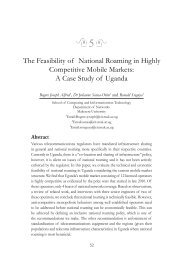Undergraduate Handbook - School of Computing and Informatics ...
Undergraduate Handbook - School of Computing and Informatics ...
Undergraduate Handbook - School of Computing and Informatics ...
You also want an ePaper? Increase the reach of your titles
YUMPU automatically turns print PDFs into web optimized ePapers that Google loves.
Reference Books:<br />
i. R. Plant <strong>and</strong> S. Murrell, An Executives Guide to Information Technology: Principles, Business Models,<br />
<strong>and</strong> Terminology, Cambridge University press, 2007.<br />
ii. S. Gordon, <strong>Computing</strong> Information Technology: The Human Side, IRM Press, 2003.<br />
BIS 1102: Business Statistics (3 CU)<br />
Course Description: Upon successful completion <strong>of</strong> this course, the student should: Underst<strong>and</strong>, <strong>and</strong> be able to<br />
apply to real problems, the fundamental concepts <strong>of</strong> statistical thinking; Be able to appropriately apply basic tools <strong>of</strong><br />
data gathering, analysis <strong>and</strong> communication to real problems; Be able to integrate basic tools into an overall<br />
approach to scientific inquiry.<br />
Indicative Content: This unit covers simple <strong>and</strong> compound interest, time value <strong>of</strong> money, annuities, present <strong>and</strong><br />
future values, data classification <strong>and</strong> terminology, describing <strong>and</strong> displaying data, probability <strong>and</strong> probability<br />
distributions, estimation <strong>and</strong> hypothesis testing, linear regression <strong>and</strong> correlation, index numbers <strong>and</strong> time series,<br />
computer analysis <strong>of</strong> data using MINITAB <strong>and</strong> EXCEL.<br />
Reference Books:<br />
i. D. R. Anderson, D. J. Sweeney, T. A. Williams, <strong>and</strong> J. Freeman, Statistics for Business <strong>and</strong> Economics,<br />
Thomson Learning; European edition, 2006.<br />
ii. M. G. Sobol, Statistics for Business <strong>and</strong> Economics: An Action Learning Approach (McGraw-Hill series in<br />
quantitative methods for management), 1982.<br />
CSC 1100: Computer Literacy (4 CU)<br />
Course Description: In this course, students are to learn about the basic organization, concepts <strong>and</strong> terminologies in<br />
a computerized environment. They are also to get an in depth underst<strong>and</strong>ing <strong>of</strong> common computer applications. The<br />
use <strong>of</strong> related applications in different operating systems will be explored. The aims <strong>of</strong> the course unit are to: Equip<br />
students with basic knowledge about computer organization; Equip students with skills <strong>of</strong> using common <strong>of</strong>fice<br />
applications; Expose students to different operating systems; Equip students with skills <strong>of</strong> how to use the Internet;<br />
<strong>and</strong> equip students with knowledge about common text editors in different operating systems. On completion <strong>of</strong> this<br />
course unit, the students will be able to: Describe the different parts <strong>of</strong> a computer; describe the historical evolution<br />
<strong>of</strong> computers; Competently use the common <strong>of</strong>fice applications in at least two operating systems <strong>and</strong> competently<br />
use common text editor in at least two operating systems.<br />
Indicative Content: General computer organisation; Historical perspectives <strong>of</strong> computing; common Micros<strong>of</strong>t<br />
<strong>of</strong>fice packages; <strong>of</strong>fice packages in other operating systems; text editors; Common Linux <strong>and</strong> Using the web.<br />
Reference Books:<br />
i. J. Preston, R. Ferret <strong>and</strong> S. Gaskin, Computer Literacy, 2007.<br />
ii. J. Janrich <strong>and</strong> D. Oja, Practical Computer Literacy, 2001.<br />
BIT 1100: Website Development & Internet Technology (3 CU)<br />
Course Description: Upon successful completion <strong>of</strong> this course, the student should: Differentiate between the<br />
Internet <strong>and</strong> the World Wide Web; Underst<strong>and</strong> basic Internet technologies such as DNS, email services, HTTP <strong>and</strong><br />
LDAP; Create, publish <strong>and</strong> maintain websites using Micros<strong>of</strong>t FrontPage / Dream weaver;<br />
Indicative Content: This course will provide an underst<strong>and</strong>ing <strong>of</strong> the basics <strong>of</strong> the Internet, how it originated, how<br />
it works, <strong>and</strong> how to develop <strong>and</strong> maintain Web sites using HTML editors <strong>and</strong> site management tools such as<br />
FrontPage <strong>and</strong>/or Dreamweaver. It will provide a basic underst<strong>and</strong>ing <strong>of</strong> Internet related technologies <strong>and</strong><br />
introductory skills in Web applications. It will introduce basic Internet technologies such as DNS, email services,<br />
LDAP <strong>and</strong> the HTTP protocol. The practical part <strong>of</strong> this course will introduce tools <strong>and</strong> techniques for specifying<br />
<strong>and</strong> prototyping interactive World Wide Web applications based on HTML.<br />
88

















